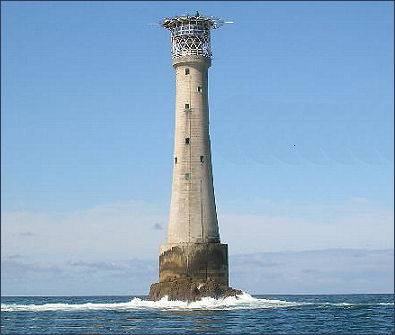Bishop Rock Lighthouse
 Bishop Rock Lighthouse, situated 4 miles to the west of the Isles of Scilly stands solidly on a rock ledge which measures 46 metres long by 16 metres wide. The rocks are exposed to the full force of the Atlantic gales rendering this one of South West England's most dramatic and most remote locations.
Bishop Rock Lighthouse, situated 4 miles to the west of the Isles of Scilly stands solidly on a rock ledge which measures 46 metres long by 16 metres wide. The rocks are exposed to the full force of the Atlantic gales rendering this one of South West England's most dramatic and most remote locations.
In the late thirteenth century, when the Isles of Scilly were ruled by John de Allet, anyone convicted of a felony "ought to be taken to a certain rock in the sea, with two barley loaves and a pitcher of water and left until the sea swallowed him up". The rock was referred to as Maen Escop in 1284. The Welsh (similar to Cornish) Maen Escob means Bishop Rock.
The rocks around the Scillies were the cause of the wreck of many ships over the centuries, including the loss known as the 1707 of Sir Cloudesley Shovel's squadron of the British Fleet in great naval disaster of 1707, in which 2,000 sailors lost their lives. The earliest recorded wreck on Bishop Rock itself was on 4th September 1839 when the brig Theodorick struck it in misty weather. It was decided that the old lighthouse at St. Agnes, was inadequate, and resolved to build a lighthouse on the most westerly hazard, the Bishop Rock.
A decision was reached by engineer in chief, James Walker in 1847 to erect a screw-pile lighthouse at a total cost of £12,000. Iron legs were screwed into the solid granite, braced and stayed with wrought iron rods. The idea was that the waves would roll freely among the piles instead of being obstructed by the solid mass of masonry. However, when the building was all but complete a heavy gale swept away the whole structure on the evening of 5th February 1850.
Undeterred, Walker replaced this structure by a tower which contained 2,500 tons of dressed granite and cost £34,560. It was first lit on 1st September 1858. The lighthouse is the second tallest in Britain, second only to the Eddystone Lighthouse. During one particularly powerful storm, waves rolled up on the side of the lighthouse and tore away the 550lb fog bell from the gallery. In 1881, Sir James Nicholas Douglass carried out renovations to reinforce the structure.
Bishop Rock was converted to automatic operation during 1991, the last keepers left the lighthouse on 21 December 1992.